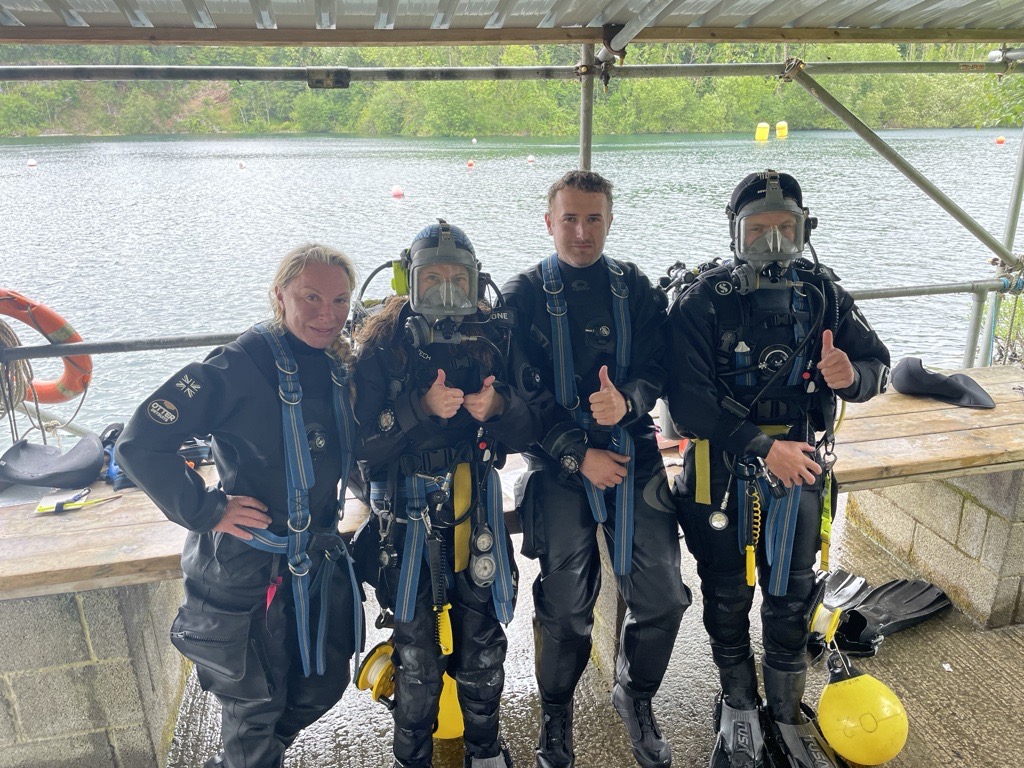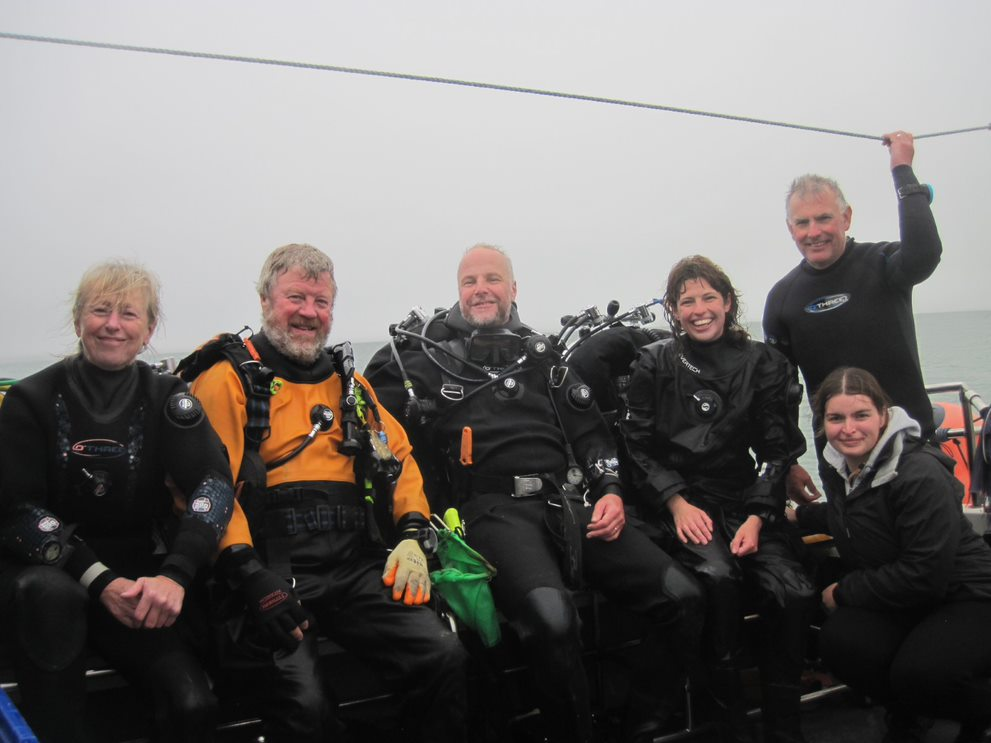In July 2023, MAT’s Project Officer Greta embarked on the HSE commercial SCUBA divers’ course at Andark Diving School, made possible thanks to the Maritime Archaeology Trust. One year later, Greta reflects on the course itself and diving at Bouldnor Cliff since.
We approach the underwater platform in Vobster Quay, our first dive, and watch as our instructor points out a nearby purposefully sunk section of a small plane to us, his fresh group of students. Clustered buoyantly together wearing half masks, we watch, anticipating what the following two weeks of this course will include. I’m so thrilled and nervous, I float examining his every move, practically shaking with anticipation. Except, that’s not anticipation now that I think of it, the more I drift there, the more my focus is pulled to my shaking body, exacerbated now that we’re not moving at all. I’m cold. Too cold. Abnormally cold, even for a UK dive. My mind falls to our hasty preparation for this exercise and my eagerness to not be the last student in the water, and then the penny drops – I didn’t double check my drysuit zip was closed.
My suspicion is confirmed post dive, when I go to climb out of the lake. Whilst dragging myself up the steep ladder, the lake water sinks, trapped inside my dry suit legs, making me look like some sort of Michelin man. Tank still on my back, I’m unable to climb the ladder much more, so I decide to tip my top half onto the wooden platform and crawl the rest of the way out. The other students have gone ahead, thank goodness, but I’m eventually noticed by one of the instructors.
‘You alright?’ he asks flatly, fully aware of what’s happened.
I nod and keep crawling.
He seems to take pity on me and sighs, in a way that I can only interpret as ‘there’s always one’, pulling my tank and weight belt off, he tells me to fully open the drysuit and lie face down with my palms on the platform. Before I manage to take a fresh breath that hasn’t been fed to me by a regulator, the instructor pulls my legs up into a sort of surprise handstand, water cascades out the suit from the open zip on my chest, momentarily drenching me.
This was one of many steep learning curves I had whilst doing my HSE course. For those who may not know, the HSE is a commercial diving course, often required for diving at work. The idea being that the training builds confidence and competence underwater, so much so that you can complete tasks like measuring, retrieving, and digging, all of which I have done since whilst diving at work. ‘Diving is secondary,’ one of our instructors says on the first day, ‘you shouldn’t even have to think about it’.
The way my first dive went, if anything, I probably need to think about it more.
Our first week is a full introduction to the equipment. Half masks are replaced by full face masks (or aga masks as some call them), and we’re given a secondary air source, a bailout. We also learn rope signals, a mixture of pulls and bells – a ‘bell’ being a tug using the quick flick of the wrist – all meaning different things in various combinations. This a form of communication that you master quickly, as taking your laminated cheat sheet underwater isn’t an option. One exercise we do to learn these signals is retrieving golf balls from a lake behind the dive school. Split into pairs, one student throws the ball into the lake and tells the submerged diver, whom they’re tethered to, which direction to go by using the rope signals. As the diver, seeing that tiny white glimmer of the golf ball in an otherwise murky lake is so thrilling, I feel like I’ve found a roman coin.

Figure 1: Student divers Sara, Greta, Alex and Charlie at Vobster Quay, having just completed the navigation task.
Shortly after we move onto comms, a voice communication system from our aga masks connecting to the surface and allowing us to speak with terrestrial workers – known as ‘topside’ – through a small box with several switches and a speaker. Before we know it, our previous solitude dives are now filled with intermittent updates to the surface, telling them when we reach the bottom, what we’re doing, and what tools we’re using. I’m starting to say ‘Roger that’ on a regular basis whilst diving. Perhaps unsurprisingly, the chatting part is probably what I pick up the easiest. One part that I wasn’t prepared for was the exams, I’m informed on the first day there’s not one exam – but five. American tables, and Canadian tables are two exams, each with their own way of figuring out what length and depth of dive requires which safety stops. Then there was a more general mathematical exam, where we learn about Henry’s law, and Dalton’s triangle and answer questions like, ‘What is the equivalent air depth for 27m using 32% nitrox?’ Despite how intimidating these exams sound, our instructors sit down with us and patiently explain the material in more detail every time us students shoot each other a look of confusion. Which on some days, becomes pretty regular.
On our second week, somehow things stepped up even more. Navigation tasks, rescue tasks, and an optional addition of a helicopter crash course, an eventful afternoon where we were strapped into seats in a metal box then dumped upside down in a pool, before pulling ourselves out the windows and gliding to the water surface. Watching the water cascade through the window as we were slowly flipped, adrenaline roaring through my body, I take an obscene amount of panic breaths thinking that will be the one to last me until I surface. We do the box flip five times, and by the end of it, I can’t think of a more exhilarating activity to do on a Wednesday afternoon. We also are instructed to complete a task to build a structure underwater in an allotted time, teaching us the importance of communicating beforehand exactly how a job is going to be done before you get in the water. Who is taking what tools, who is expected to do what part of the task, and more importantly how you all get back out of the water safely. I will never forget preparing to jump off a rib boat in the Solent, fully kitted up on the cusp of plunging in, when my instructor asked me exactly how I was planning to get back into the boat when there was no ladder and no lift. I guess a pull up with a tank and weight belt on wasn’t going to work. Possibly the most memorable activity that we had to complete was the blindfold construction task. Walking into the classroom that morning, I sit down and saw this on the board before turning to my classmate,
‘That’s not for us, is it?’ I ask, trying my best to cover the mild panic.
It was for us.
Our final practical task, the last hurdle, after several exams and sixteen dives, was to blindfold ourselves and construct an object underwater within a certain time frame. This was only in 2metre water in the dive school lake, so hardly the Mariana trench, but it was enough. Testing your ability to work in atrocious visibility, as our instructor reminds us, is imperative. I remember, as the grease paper was being stuck to the inside of my mask, and I was gently guided backwards into the water, thinking to myself ‘am I really ever going to use this skill?’, but having dived since at Bouldnor Cliff, digging up sediment and patiently waiting for it to clear with little success, I can confirm this is probably the skill I have used the most. After entering the lake, I sit on my knees underwater, with only bits of blurry light penetrating through my mask, and the sound of my deep Darth Vader breathing. The single connection I have with the outside world is occasionally brushing the arm of my work partner as we pass each other spanners and the structural elements. My thought process is at one point interrupted by my classmate on the surface, signalling into my helmet’s earpiece, checking how much air I have. There’s a pause, and moments after I can hear infectious laughter ringing down the microphone, as they’ve realised there is no possible way a diver who can’t see their hand in front of their face can check any gauge. It may seem strange for me get the giggles when situated in these circumstances, but after the initial claustrophobic feeling subsides, there’s a strange period of tranquillity leaving room for humour, and even excitement that you’re doing it, you’re working with someone to build a structure underwater without being able to see a single thing.

Figure 2: Greta on the dive boat at Bouldnor Cliff with the Maritime Archaeology Trust and volunteers
Sitting in the pub after our final exam, and having just been awarded our HSE certificates, my fellow students and I reflect on what a mad two weeks it had been. We clink our drinks together and share what we were hoping to do with our qualifications. Despite the short time together, we’d bonded in camaraderie through the intensity of the course. Early mornings, a night dive, tasks and activities I would have never dreamed I’d be able to complete. Having been a diver since I was thirteen, it has been an incredible test of ability and an unforgettable experience, a massive thank you to the Maritime Archaeology Trust for this opportunity and to Andark dive school. I would whole-heartedly recommend the HSE to anyone thinking of pursuing commercial diving.
Just remember to close your drysuit.
